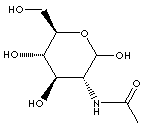| CAS
NO. |
7512-17-6 |

|
| EINECS. |
233-115-1 |
| FORMULA |
C8H15NO6 |
| MOL WT. |
221.21 |
|
H.S. CODE |
2932.99.9090 |
|
TOXICITY |
|
|
SYNONYMS |
NAG; GlcNAc; N-Acetyl-D-glucosaminide; Acetylglucosamine; |
| 2-Acetamido-2-deoxy-D-glucopyranose; N-乙酰氨基葡萄糖; N-Acetylchitosamine;
2-Acetamido- 2-deoxy- alpha-glucopyranose; N-Acetyl-D-glucosamine; 2-(acetylamino)-2-deoxy-D-glucose; 2-Acetamido-2-deoxy-D-glucose; N-Acetylglucosamine; N-Acetyl-beta-D-glucosamine; N-Acetyl-beta-D-glucosaminide; Other RN: 134-61-2, 7132-76-5, 98632-70-3, 173382-53-1, 948887-87-4 |
|
SMILES |
N([C@@H]1[C@H]([C@@H]([C@@H](CO)O[C@H]1O)O)O)C(C)=O |
| CLASSIFICATION |
|
| EXTRA NOTES |
|
|
PHYSICAL AND CHEMICAL PROPERTIES
|
| PHYSICAL
STATE |
white crystalline powder |
| MELTING POINT |
195
- 205 C
|
| BOILING
POINT |
|
| SPECIFIC GRAVITY |
|
| SOLUBILITY
IN WATER |
soluble |
| pH |
7.0
- 8.5 |
| VAPOR DENSITY |
|
|
AUTOIGNITION
|
|
|
NFPA
RATINGS
|
|
|
REFRACTIVE
INDEX
|
|
| FLASH
POINT |
|
| STABILITY |
Stable
under ordinary condiions |
|
GENERAL
DESCRIPTION & APPLICATION
|
|
Glucosamine is the most abundant naturally occurring amino sugar in which one or
more nonglycosidic hydroxyl groups are replaced by an amino or substituted amino
group. Glucosamine is a glucose substituted at the 2 position. It is present in
peptidoglycans and variety of complex polysaccharides such as blood group
substances. It is generally acetylated (N-acetylglucosamine). It is the basic
structural unit of chitin which is a linear unbranched homopolymer composed of
N-acetyl-D-glucosamine residues in beta-linkage (1,4) like cellulose. Chitin is
the principal constituent of arthropod exoskeletons to cover the surface of the
body, found mainly in crab, lobster or shrimp shell. Chitin is also found in the
cell walls of some fungi. Muramic acid is a compound consisting of glucosamine
and lactic acid joined by an ether linkage. It is the characteristic
polysaccharide composing bacterial cell walls. Chitosan is the de-acetylation
form of chitin; a polysaccharide composed of repeating glucosamine units. It is
used to absorb heavy metals in water treatment. Chondroitin is a
glycosaminoglycan composed of a sulfated (C-4 or C-6) N-acetylgalactosamine
residue linked to a glucuronic acid residue. It is the It consists of repeating
disaccharide units. It is abundant in connective tissues, particularly in the
ground substance of blood vessels, bone, and cartilage. Chondroitin sulfate A
is sulfated on C-4 position and called also chondroitin 4-sulfate to dominate
the position of the sulfate group on the sugar, while Chondroitin sulfate C is
chondroitin 6-sulfate. Chondroitin sulfate B is another name of dermatan sulfate
which is sulfated on the C-4 position but also the C-5 of the uronic acid is
under the epimerisation of glucuronic acid to iduronic acid. Glucosamine and
chondroitin sulfate are being tested for potential benefit in osteoarthritis.
They are stabilizd with hydrochloride or sulfur to be used as dietary or
nutritional supplements. Glucosamine is believed to contribute to the pain
relief of cartilage and structure rebuilding of cartilage in the joint. N-acetyl-glucosamine
is a building
block of connective tissues to hold cells together. It is reported that
NAG plays role in mucous
membranes such as in the digestive also. NAG layer plays role in tissue rebuilding
and the digestive tract. |
| SALES
SPECIFICATION |
|
APPEARANCE
|
white crystalline powder |
|
ASSAY |
98.0%
min |
|
HEAVY
METALS |
10ppm
max
|
|
ARSENIC
|
1ppm
max
|
|
IRON
|
10ppm
max
|
|
CHLORIDE
|
1.0%
max
|
|
MELTING
POINT
|
195
- 205 C
|
|
RESIDUE
ON IGNITION
|
0.1%
max
|
|
SPECIFIC
ROTATION
|
+39°
~ +43°
|
|
LOSS
DRYING
|
0.5%
max
|
| TRANSPORTATION |
| PACKING |
|
| HAZARD CLASS |
not
regulated |
| UN
NO. |
|
| OTHER
INFORMATION |
|
|
